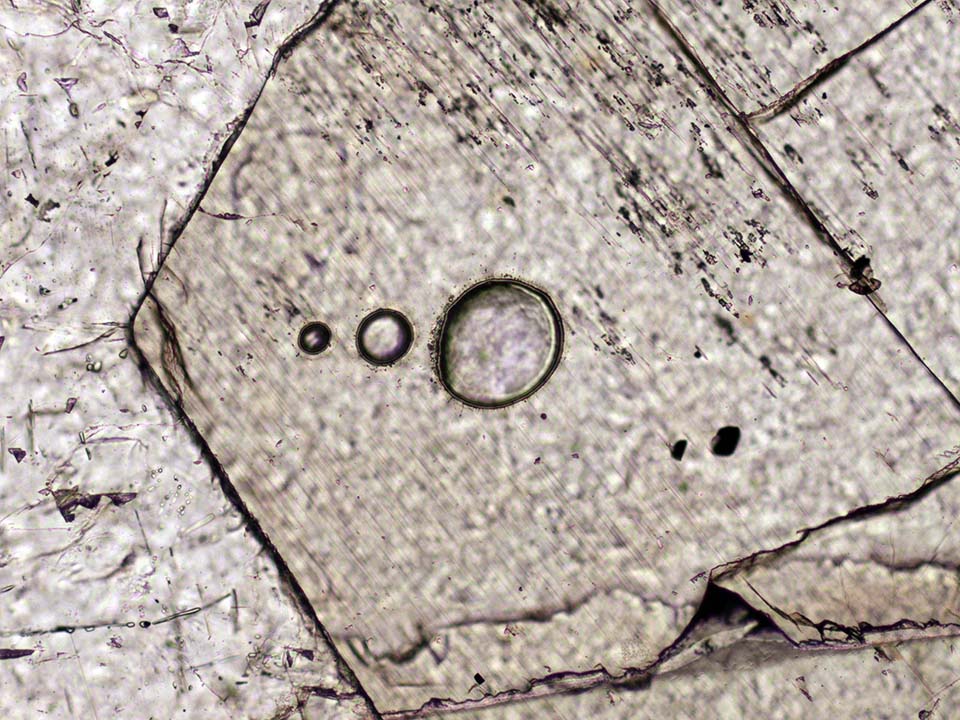Bulletin of the Geological Survey of Japan Top Page
Bulletin of the Geological Survey of Japan Vol.66 No.9/10 (2015)
Cover photograph | Table of Contents | Abstract
Cover photograph
Photomicrograph of craters after laser ablation of clinopyroxene
Photomicrograph shows craters (100, 40 and 20 μm in decreasing order of size) after laser ablation of clinopyroxene (open Nicol) using laser ablation-inductively coupled plasma-mass spectrometer (LA-ICP-MS) at GSJ-Lab. Pale-greenish brown portion with craters is clinopyroxene and whitish (transparent) portion is plagioclase. Field of view = 0.8 mm.
(Photograph and Caption by Toru Yamasaki)
Table of Contents
All the pages PDF : 66_09_full.pdf [2.6MB]
| Title | Author | |
|---|---|---|
| Report | ||
| Multiple trace element analyses for silicate minerals and glasses by laser ablation-inductively coupled plasma-mass spectrometry (LA-ICP-MS) | Toru Yamasaki, Kohei Yamashita, Masatsugu Ogasawara and Genji Saito (p179-197) | 66_09_01.pdf [2MB] |
Abstract
Multiple trace element analyses for silicate minerals and glasses by laser ablation-inductively coupled plasma-mass spectrometry (LA-ICP-MS)
Toru Yamasaki, Kohei Yamashita, Masatsugu Ogasawara and Genji Saito
Programs were established in the shared research facilities of the Geological Survey of Japan (GSJ-Lab) for trace element analysis of silicate minerals and glasses in microspots using laser ablationinductively coupled plasma-mass spectrometry (LA-ICP-MS). National Institute of Standards and Technology (NIST) synthetic glasses reference materials (NIST 613 and NIST 611) were used as external calibration standards, and suitable instrumental operation settings were set as follows; 0.5 L min-1 He carrier gas flow rate, 100 μm laser spot diameter, 5 Hz repetition rate, and 40 % laser energy (fluence ca. 2.0 J cm-2). NIST 615 and NIST 613 were analyzed as unknown samples to evaluate precision and accuracy. Precision was mostly less than 30 % for 45 elements from 45Sc to 238U for laser spot diameters ranging from 100 to 10 μm. Accuracy was evaluated according to the difference (DIF) between the analytical results and reference values in the literature. Accuracy for the analysis of NIST 613 was DIF < 30 %, except for Sc, Mn, Ni, and Ge. For NIST 615, DIF was less than 30 %, except for Tl with laser spot diameters of 20 and 10 μm, and for Cd with a laser spot diameter of 20 μm. The depths of laser pits for generic conditions for the analysis of clinopyroxene, amphiboles and plagioclase were estimated as extents without penetration of the thin section samples. Two suites of analytical programs (34 and 27 elements) were additionally prepared for general purpose petrological and geochemical discussion and the accuracy of both was evaluated. The DIFs for the suite of 34 elements were mostly less than 30 %, although some for Cr, Mn, Ni, and Cs with laser spot diameters < 40 μm exceeded 30 %. In the suite of 27 elements, the DIFs were < 30 %, except for Sc.
Geological Survey of Japan, AIST
- About GSJ
- Our Activities
- Purchase guide
-
Publications and Database
- information
- Bulletin of the Geological Survey of Japan
- bull2025(Vol.76)
- bull2024(Vol.75)
- bull2023(Vol.74)
- bull2022(Vol.73)
- bull2021(Vol.72)
- bull2020(Vol.71)
- bull2019(Vol.70)
- bull2018(Vol.69)
- bull2017(Vol.68)
- bull2016(Vol.67)
- bull2015(Vol.66)
- bull2014(Vol.65)
- bull2013(Vol.64)
- bull2012(Vol.63)
- bull2011(Vol.62)
- bull2010(Vol.61)
- bull2009(Vol.60)
- bull2008(Vol.59)
- bull2007(Vol.58)
- bull2006(Vol.57)
- bull2005(Vol.56)
- bull2004(Vol.55)
- bull2003(Vol.54)
- bull2002(Vol.53)
- bull2001(Vol.52)
- Bulletin of the Geological Survey of Japan(old)
- Annual Report on Active Fault and Paleoearthquake Researches
- Reports, Geological Survey of Japan
- CCOP-GSJ Groundwater Project Report
- CCOP Technical Bulletin
- Cruise Report
- Geological Hazards
- Learning and Education
- GSJ Database Collection
- Collection of links


